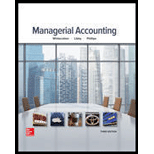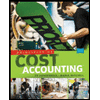
Managerial Accounting
3rd Edition
ISBN: 9780077826482
Author: Stacey M Whitecotton Associate Professor, Robert Libby, Fred Phillips Associate Professor
Publisher: McGraw-Hill Education
expand_more
expand_more
format_list_bulleted
Concept explainers
Question
Chapter 4, Problem 2.1GAP
To determine
Concept introduction:
Predetermined overhead allocation:
To calculate:
The amount of overhead assigned to each product line using the traditional costing.
Expert Solution & Answer
Want to see the full answer?
Check out a sample textbook solution
Students have asked these similar questions
Please explain the solution to this general accounting problem with accurate principles.
Give me correct answer this general accounting question
I am searching for the correct answer to this general accounting problem with proper accounting rules.
Chapter 4 Solutions
Managerial Accounting
Ch. 4 - What is the difference between a volume-based cost...Ch. 4 - Explain the statement that traditional costing...Ch. 4 - Prob. 3QCh. 4 - How does activity-based costing differ from...Ch. 4 - What types of business might use activity-based...Ch. 4 - Prob. 6QCh. 4 - Prob. 7QCh. 4 - Prob. 8QCh. 4 - Why must costs be classified into different...Ch. 4 - Prob. 10Q
Ch. 4 - Prob. 11QCh. 4 - Explain the difference between the activity-rate...Ch. 4 - Define activity-based management and explain how...Ch. 4 - Prob. 14QCh. 4 - Prob. 15QCh. 4 - What is non-value-added activity. Considering the...Ch. 4 - Prob. 17QCh. 4 - Prob. 18QCh. 4 - Prob. 19QCh. 4 - Prob. 20QCh. 4 - Prob. 1MCCh. 4 - Both traditional and ABC cost systems focus on...Ch. 4 - Prob. 3MCCh. 4 - Number of setups is an example of a a. Unit-level...Ch. 4 - Prob. 5MCCh. 4 - Prob. 6MCCh. 4 - Prob. 7MCCh. 4 - Prob. 8MCCh. 4 - Prob. 9MCCh. 4 - Prob. 10MCCh. 4 - Prob. 1MECh. 4 - Prob. 2MECh. 4 - Prob. 3MECh. 4 - Identifying terms in ABC and ABM Use the following...Ch. 4 - Prob. 5MECh. 4 - Prob. 6MECh. 4 - Assigning Costs Using Activity Proportions Refer...Ch. 4 - Calculating Activity Rates for ABC System Lakeside...Ch. 4 - Prob. 9MECh. 4 - Prob. 10MECh. 4 - Prob. 11MECh. 4 - Prob. 12MECh. 4 - Classifying Activities According to Level,...Ch. 4 - Prob. 2ECh. 4 - Prob. 3ECh. 4 - Assigning Costs Using Activity Rates Refer to the...Ch. 4 - Prob. 5ECh. 4 - Prob. 6ECh. 4 - Prob. 7ECh. 4 - Prob. 8ECh. 4 - Prob. 9ECh. 4 - Prob. 10ECh. 4 - Comparing Traditional Costing Systems and...Ch. 4 - Prob. 12ECh. 4 - Prob. 13ECh. 4 - Prob. 14ECh. 4 - Prob. 15ECh. 4 - Identifying Value-Added and Non-Value-Added...Ch. 4 - Prob. 17ECh. 4 - Prob. 18ECh. 4 - Calculating Target Cost Majesty Company uses...Ch. 4 - Assigning Costs using Traditional System, ABC...Ch. 4 - Assigning Costs using Traditional System, ABC...Ch. 4 - Prob. 1.3GAPCh. 4 - Prob. 1.4GAPCh. 4 - Prob. 1.5GAPCh. 4 - Prob. 2.1GAPCh. 4 - Prob. 2.2GAPCh. 4 - Prob. 2.3GAPCh. 4 - Prob. 2.4GAPCh. 4 - Prob. 2.5GAPCh. 4 - Prob. 3.1GAPCh. 4 - Prob. 3.2GAPCh. 4 - Prob. 3.3GAPCh. 4 - Prob. 3.4GAPCh. 4 - Prob. 3.5GAPCh. 4 - Prob. 3.6GAPCh. 4 - Prob. 3.7GAPCh. 4 - Prob. 3.8GAPCh. 4 - Prob. 4.1GAPCh. 4 - Describing the Impact of ABM and TQM on a Company...Ch. 4 - Prob. 4.3GAPCh. 4 - Prob. 4.4GAPCh. 4 - Describing the Impact of ABM and TQM on a Company...Ch. 4 - Prob. 4.6GAPCh. 4 - Prob. 4.7GAPCh. 4 - Prob. 4.8GAPCh. 4 - Prob. 5.2GAPCh. 4 - Prob. 1.1GBPCh. 4 - Prob. 1.2GBPCh. 4 - Prob. 1.3GBPCh. 4 - Prob. 1.4GBPCh. 4 - Prob. 1.5GBPCh. 4 - Prob. 2.1GBPCh. 4 - Prob. 2.2GBPCh. 4 - Prob. 2.3GBPCh. 4 - Prob. 2.4GBPCh. 4 - Prob. 2.5GBPCh. 4 - Prob. 3.1GBPCh. 4 - Selecting Cost Drivers, Assigning Costs using...Ch. 4 - Prob. 3.3GBPCh. 4 - Prob. 3.4GBPCh. 4 - Prob. 3.5GBPCh. 4 - Prob. 3.6GBPCh. 4 - Prob. 3.7GBPCh. 4 - Prob. 3.8GBPCh. 4 - Prob. 4.1GBPCh. 4 - Prob. 4.2GBPCh. 4 - Prob. 4.3GBPCh. 4 - Prob. 4.4GBPCh. 4 - Selecting Cost Drivers, Assigning Costs Using...Ch. 4 - Prob. 4.6GBPCh. 4 - Prob. 4.7GBPCh. 4 - Prob. 4.8GBPCh. 4 - Defining Concepts of Target Costing, Just-in-Time,...Ch. 4 - Defining Concepts of Target Costing, Just-in-Time,...
Knowledge Booster
Learn more about
Need a deep-dive on the concept behind this application? Look no further. Learn more about this topic, accounting and related others by exploring similar questions and additional content below.Similar questions
- The gross profit for dalton company is?arrow_forwardCan you help me solve this general accounting question using valid accounting techniques?arrow_forwardQuestion: The packaging activity has an expected cost of $150,000. Expected direct labor hours are 25,000, and the expected number of packages is 75,000. The best activity rate for packaging is _.arrow_forward
- Which of the following accounts is a permanent account?a) Rent Expenseb) Sales Revenuec) Accounts Payabled) Dividendsarrow_forwardI am looking for the correct answer to this general accounting question with appropriate explanations.arrow_forwardCan you solve this financial accounting problem using accurate calculation methods?arrow_forward
arrow_back_ios
SEE MORE QUESTIONS
arrow_forward_ios
Recommended textbooks for you
- Principles of Accounting Volume 2AccountingISBN:9781947172609Author:OpenStaxPublisher:OpenStax College
 Managerial Accounting: The Cornerstone of Busines...AccountingISBN:9781337115773Author:Maryanne M. Mowen, Don R. Hansen, Dan L. HeitgerPublisher:Cengage Learning
Managerial Accounting: The Cornerstone of Busines...AccountingISBN:9781337115773Author:Maryanne M. Mowen, Don R. Hansen, Dan L. HeitgerPublisher:Cengage Learning Managerial AccountingAccountingISBN:9781337912020Author:Carl Warren, Ph.d. Cma William B. TaylerPublisher:South-Western College Pub
Managerial AccountingAccountingISBN:9781337912020Author:Carl Warren, Ph.d. Cma William B. TaylerPublisher:South-Western College Pub  Cornerstones of Cost Management (Cornerstones Ser...AccountingISBN:9781305970663Author:Don R. Hansen, Maryanne M. MowenPublisher:Cengage Learning
Cornerstones of Cost Management (Cornerstones Ser...AccountingISBN:9781305970663Author:Don R. Hansen, Maryanne M. MowenPublisher:Cengage Learning Principles of Cost AccountingAccountingISBN:9781305087408Author:Edward J. Vanderbeck, Maria R. MitchellPublisher:Cengage Learning
Principles of Cost AccountingAccountingISBN:9781305087408Author:Edward J. Vanderbeck, Maria R. MitchellPublisher:Cengage Learning Survey of Accounting (Accounting I)AccountingISBN:9781305961883Author:Carl WarrenPublisher:Cengage Learning
Survey of Accounting (Accounting I)AccountingISBN:9781305961883Author:Carl WarrenPublisher:Cengage Learning

Principles of Accounting Volume 2
Accounting
ISBN:9781947172609
Author:OpenStax
Publisher:OpenStax College

Managerial Accounting: The Cornerstone of Busines...
Accounting
ISBN:9781337115773
Author:Maryanne M. Mowen, Don R. Hansen, Dan L. Heitger
Publisher:Cengage Learning

Managerial Accounting
Accounting
ISBN:9781337912020
Author:Carl Warren, Ph.d. Cma William B. Tayler
Publisher:South-Western College Pub

Cornerstones of Cost Management (Cornerstones Ser...
Accounting
ISBN:9781305970663
Author:Don R. Hansen, Maryanne M. Mowen
Publisher:Cengage Learning

Principles of Cost Accounting
Accounting
ISBN:9781305087408
Author:Edward J. Vanderbeck, Maria R. Mitchell
Publisher:Cengage Learning

Survey of Accounting (Accounting I)
Accounting
ISBN:9781305961883
Author:Carl Warren
Publisher:Cengage Learning
Cost Accounting - Definition, Purpose, Types, How it Works?; Author: WallStreetMojo;https://www.youtube.com/watch?v=AwrwUf8vYEY;License: Standard YouTube License, CC-BY